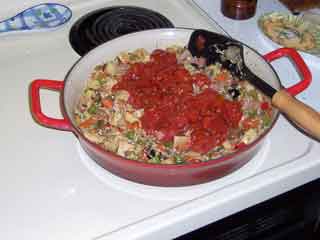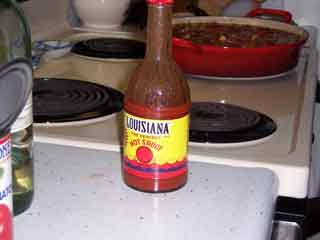Jambalayas are just nice mixtures of rice, tomatoes, meat(s), and anything else you'd like to throw in to make it interesting. The traditional recipes call for chicken, ham, rice, onion, tomato and spices. I like to add some mushrooms, garlic, red and green sweet peppers, carrots, ripe olives, and, of course, anything else that's hanging around in the refrigerator that needs to be used up. My problem used to be finding a skillet large enough to hold it all, but now, thanks again to Eric, that’s no trouble at all!
Serve it with crunchy French bread and a tossed green salad with a cool, mild dressing.
To build a batch big enough to serve 4 (or to serve two twice),
here's what you'll need . . .
2 boneless, skinless chicken breasts
1 medium onion (bigger than a golf ball, smaller than a tennis ball)
1 cup uncooked long grain white rice
2 or 3 cans tomatoes
2 - 4 cups 'liquid' (water, chicken stock, juice from tomatoes, white wine, whatever you like)
¼ cup (or more or less) Louisiana Hot Sauce
olive oil
fresh, coarsely ground black pepper (Tellicherry, of course!)
Optional ingredients include:
cooked ham (about ½ cup cubed)
red and/or green peppers (about ½ cup total, chunked or chopped)
fresh mushrooms (about 6 medium sized, chunked or thick sliced or chopped or any combination of the above)
1 medium sized fresh carrot (thin sliced half-rounds or chopped any way you like)
1 stalk celery (chopped or sliced)
1 or 2 medium sized cloves of garlic (minced)
12 ripe olives (halved or quartered)
6 to 12 strands of spaghetti (broken into 1" pieces)
1 or 2 bay leaves
pinches of thyme, oregano, basil (today’s batch uses oregano and cilantro)
1 small jalapeno pepper (skinned and de-seeded, or canned), diced, sliced, or chopped

Here's how you do it.
Cube the chicken into pretty good-sized hunks. We usually get about 25 - 30 pieces out of two breasts. (If you're adding ham, get it cut up now as well). Set aside on a plate (and grind some black pepper on the chicken cubes, if you like).
Chop the onion and any of the other vegetables you're planning to include. Set aside (in neat little piles, of course) on a plate. Mince the garlic, break the spaghetti, and set out the bay leaves and spices, if you're planning on using them.
(If you're stuck with an electric stove, as I am, now is a good time to start heating your skillet.)
Open the tomatoes and drain the liquid into a measuring cup. Add a slug of white wine or any of the other liquids you want to use to the measuring cup. Then fill it up to two or three cups (or so, different batches of rice require a little more or a little less liquid) with water.
You'll need a large deep skillet - at least 12" (14" or 16" would be better, but they don't seem to sell them at WalMart), or a fancy Le Creuset like the one Eric gave me, or a Dutch oven or a . . . Get the pan hot (about ‘4 o’clock’ on my stove's dial), add about 2 Tbsp. olive oil, swirl a couple of times till you can smell the oil's aroma and toss in the chicken. Shake, toss, flip, turn or otherwise keep the chicken in motion until it is sealed on all sides. You can either keep it moving until it's lightly browned or turn the heat down a notch so you can leave it for a minute or three to clean up the mess you've made so far. (Since the ham is already cooked, you can add it later.)

Now, if you want your chicken 'hot' rather than only having the dish 'hot', this is the time to add the first slugs of Louisiana Hot Sauce. I don't usually measure out the hot sauce before cooking the dish. I just give the bottle a few judicious shakes from time to time. At this stage, add about 3 or 4 good solid shakes to make the chicken ‘hot’; otherwise, you can wait and add all the hot sauce later, after you get the liquid in.

When the chicken is about half way to lightly browned, toss in the vegetables (and if you turned the heat down above, turn it back up now - you'll need it.) Start with carrots, if you're using them; then onions; then mushrooms and peppers; then garlic, jalapenos, olives (and anything else you might have found lying around). The idea is to have all this stuff 'cooked' by the time the chicken is nicely browned.

There should be plenty of oil/chicken grease left in the pan for the next part, but if not, you can add another Tbsp. of olive oil and you probably want to push the chicken and vegetable mix over to the sides of the pan to give yourself some room. If you're using spaghetti, it goes in next. You want to brown the pasta in the hot oil.

Then toss in the rice and stir it around for a minute or four until every last grain is thoroughly coated with oil. You don't want the rice to start browning, but you do want it to start cooking, so keep it moving. If you're a time-control freak, the rice should be stirred around continuously for at least 5 minutes, but no more than 8 minutes.

When you're sick of coating/cooking the rice, stir everything together until is is nicely mixed. Add the tomatoes and kind of chop them up with the edge of your spatula (you want chunks, not mush). When everything's nicely mixed, swirl, shake, jiggle, flip and/or stir the whole mess for about 3 or 4 minutes. On the last swirl, jiggle, or flip, add the bay leaf and move it around enough to get it moist.

If you're using the spices, they can be tossed in now. And, if you did not grind black pepper all over the chicken while it was sitting on the plate earlier, grind it all over everything now.

Now, pour in the liquid and stir everything all around until it's thoroughly mixed. If you've kept the pan hot enough, the whole mess should be bubbling by the time you've got everything mixed up.

Now add the remaining hot sauce (or all of it if you didn't put any in earlier) and stir it in a couple of times. I usually add between 12 and 20 good 'splooshes' at this point (in addition to the 3 or 5 or 6 I added earlier). You'll have to experiment to find the right amount for your own taste. (If you like Old El Paso Thick and Chunky Salsa in the mild version, go for 12. If you like the medium version, go for 20. If you like the hot version, you're on your own!) When I started, this 12 oz. bottle of hot sauce was unopened . . .

Now reduce the heat to low and cook the mess for at least an hour. You want it to be bubbling gently, not frothing all over the stove and not just sitting there with a little steam rising. Depending on atmospheric pressure, barometric readings, humidity, the month of the year in which your rice was harvested and the phase of the moon, the cooking time in the skillet can range from 1 to 2 hours.

When all the free liquid has been absorbed and the rice is tender (yes, you'll have to try a spoonful to tell), then it's time to preheat the oven to about 375° F or so, set the table, put out the salad and dressing and get ready to eat. You're about 10 minutes away (depending on how fast your oven preheats!)

Stick the pan full of Jambalaya into the oven (uncovered) to 'dry out' for a few minutes. (Or, if your pan isn’t oven safe, put a little olive oil in the bottom of a baking dish to keep the Jambalaya from sticking, and transfer the contents of the skillet to the baking dish.) Stick the French bread in the oven at the same time. In about 5 to 10 minutes the Jambalaya should be ready for the table, the French bread should be crunchy, the salad and dressing should be at perfect serving temperature, and it's time to PIG OUT!

No comments:
Post a Comment